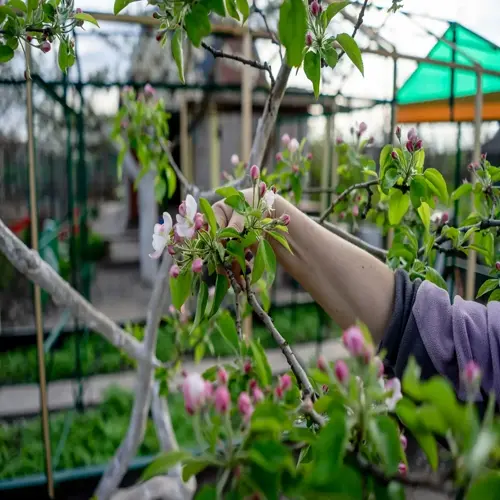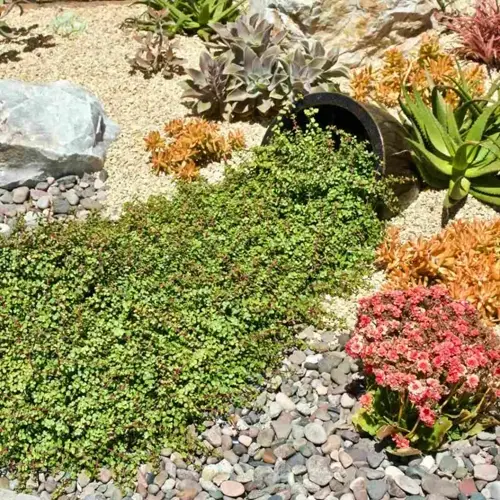20 Edible Flower Varieties for Gourmet Gardens

Written by
Michael Sullivan
Reviewed by
Prof. Samuel Fitzgerald, Ph.D.Discover 20 edible flower varieties with unique flavors from peppery nasturtiums to sweet violets.
Grow successfully with zone-specific care, well-draining soil, and 6+ hours of sunlight daily.
Enhance dishes using flowers in savory meals, desserts, beverages, and professional garnishes.
Harvest safely by identifying toxic lookalikes like hemlock and following morning-picking protocols.
Boost garden ecosystems by attracting pollinators with bee balm, milkweed, and other nectar-rich varieties.
Avoid myths: colorful doesn't mean edible, washing doesn't remove pesticides, and moderation is crucial.
Article Navigation
Change ordinary plates into brilliant canvases with edible varieties of flowers. They are beautiful, but they also add exciting flavors to dishes. Sample the sweet gentleness of roses and the peppery bloom of nasturtiums. Each flower offers a delightful, thrilling experience that can be easily cultivated in your garden.
We carry twenty or more kinds instead of the ordinary ten or fifteen flower lists. This guide will show you how to cultivate a gourmet garden worthy of its name, full of edible delights. You will be amazed at the versatility of these blooms. They will transform salads, desserts, and drinks into the extraordinary. Begin with easy-to-grow plants, such as calendula or borage.
20 Edible Flower Varieties
Here are twenty varieties of edible flowers, along with their flavors. Nasturtium is peppery and great in salads. Borage tastes like cucumber and is great in drinks. Calendula provides a saffron-like color in rice dishes. Lavender is floral and sweet in desserts. Squash blossoms complement delicate recipes for stuffing.
Chive blossoms have a mild onion flavor, making them an ideal addition to savory dishes. Bee balm has a citrus aroma that pairs well with teas and jellies. Roses add perfumed elegance to syrups and cakes. Violets have a sweet, wintergreen-like scent, making them suitable for use in candy. Sunflower petals give an earthy crunch to summer salads.
Pansies offer colorful decoration, but with subtle grassy overtones. The flowers of arugula give spice to pizza toppings. Dianthus has a clove-like quality, which is pleasing in fruit salads. Thyme flowers enhance meats with considerable herbal flavor. Chamomile lends an apple-like flavor and fragrance to infusions and baked goods.
Hibiscus contributes a tangy, cranberry-like flavor to liquids. Lilac imparts a floral scent to honeys and sugars. Marigold petals enhance the color of stews to a rich, golden hue. Day lily buds offer a hint of asparagus in stir-frying. Mint blossom refreshes the cocktail and the fruit salad.

Nasturtium
- Flavor Profile: Peppery and slightly spicy, similar to watercress with a mustard-like kick that adds zest to dishes
- Appearance: Vibrant trumpet-shaped blooms in sunset hues of orange, yellow, and red with rounded green leaves
- Culinary Uses: Whole flowers elevate salads, sandwiches, and appetizers; leaves add spice to pesto and sauces
- Growing Tips: Thrives in full sun with moderate watering; plant seeds 1/2 inch (1.27 cm) deep after last frost in well-draining soil
- Harvest & Storage: Pick blossoms mid-morning after dew dries; store in damp paper towels up to 3 days refrigerated
- Nutritional Fact: Rich in vitamin C and antioxidants like lutein; contains natural antibacterial properties
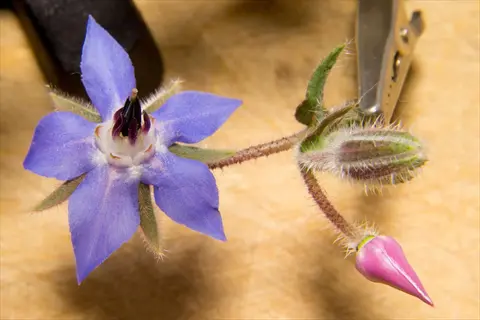
Borage
- Flavor Profile: Refreshing cucumber taste with subtle sweetness, ideal for cooling summer beverages and dishes
- Appearance: Star-shaped blue blossoms with hairy stems and leaves; grows 2-3 feet (60-90 cm) tall with gray-green foliage
- Culinary Uses: Petals garnish cocktails, salads, and desserts; freeze whole flowers in ice cubes for decorative drinks
- Growing Tips: Prefers full sun to partial shade; self-seeds readily in zones 2-11 with minimal maintenance required
- Harvest & Storage: Collect flowers when fully open; best used fresh but can be candied or dried for teas
- Nutritional Fact: High in gamma-linolenic acid (GLA), an omega-6 fatty acid that supports skin health
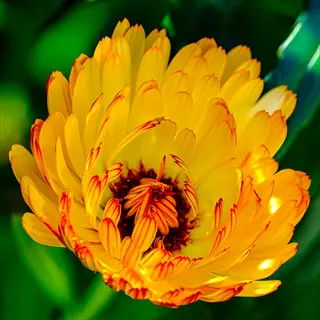
Calendula
- Flavor Profile: Mildly bitter with earthy notes, often compared to saffron when used as a seasoning or coloring agent
- Appearance: Daisy-like flowers in bright orange and yellow hues; petals form dense layers around dark centers
- Culinary Uses: Petals add color to rice, soups, and stews; infuse oils for salad dressings and marinades
- Growing Tips: Drought-tolerant annual; plant in full sun after frost; blooms continuously when deadheaded regularly
- Harvest & Storage: Pick petals midday; dry on screens for storage in airtight containers away from sunlight
- Nutritional Fact: Contains anti-inflammatory compounds like flavonoids and carotenoids that support immunity
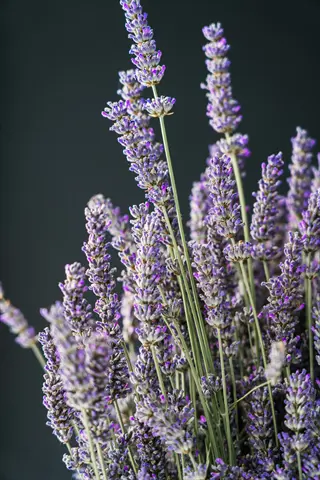
Lavender
- Flavor Profile: Sweet floral aroma with herbaceous notes; intense perfume-like taste best used sparingly
- Appearance: Spikes of tiny purple flowers on silvery-green stems; grows in compact bushes up to 3 feet (90 cm) tall
- Culinary Uses: Flavor baked goods, syrups, and ice cream; pair with lemon or honey in teas and desserts
- Growing Tips: Requires full sun and alkaline soil; prune annually in spring to maintain shape and productivity
- Harvest & Storage: Cut stems before flowers fully open; hang upside down in dark, dry place for preservation
- Nutritional Fact: Rich in calming compounds like linalool; may help reduce stress and improve sleep quality
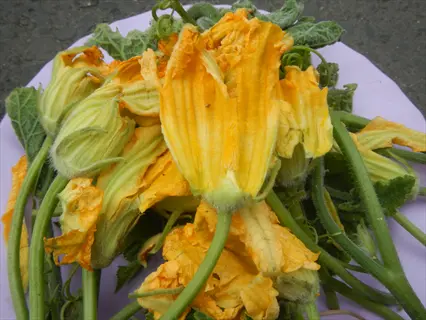
Squash Blossoms
- Flavor Profile: Delicate vegetal taste similar to zucchini; subtle sweetness with tender, velvety texture
- Appearance: Bright yellow-orange trumpet-shaped flowers; male blossoms have thin stems while female have miniature fruit
- Culinary Uses: Stuff with ricotta and herbs; batter and fry; chop into omelets or pasta for color and texture
- Growing Tips: Plant squash seeds in full sun after frost; harvest male blossoms to avoid reducing fruit production
- Harvest & Storage: Pick early morning; use same day for best quality or refrigerate wrapped in damp towels
- Nutritional Fact: Good source of vitamins A and C; contains lutein for eye health and beta-carotene

Chive Blossoms
- Flavor Profile: Mild onion flavor more delicate than chive stems; subtle garlic notes without harsh pungency
- Appearance: Round clusters of tiny purple florets atop hollow green stems; forms dense clumps in gardens
- Culinary Uses: Separate florets over potatoes, soups, and salads; infuse vinegar for pink-hued dressings
- Growing Tips: Perennial in zones 3-9; divide clumps every 3 years in spring for continuous blooming
- Harvest & Storage: Cut entire flower heads; refrigerate in sealed containers for up to one week
- Nutritional Fact: Contains allicin, a sulfur compound with antibacterial and antifungal properties
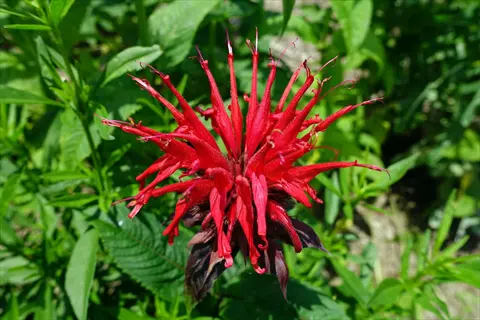
Bee Balm
- Flavor Profile: Complex blend of mint, citrus, and oregano; sweet yet slightly spicy with herbal notes
- Appearance: Shaggy tubular flowers in red, pink, or purple; square stems with aromatic lance-shaped leaves
- Culinary Uses: Brew into teas; flavor fruit salads and desserts; garnish lemonades and summer cocktails
- Growing Tips: Prefers moist soil and full sun; space plants 18-24 inches (45-60 cm) apart to prevent powdery mildew
- Harvest & Storage: Pick flowers just after opening; dry petals for year-round use in airtight containers
- Nutritional Fact: Rich in thymol, a compound with antiseptic properties that supports respiratory health

Rose
- Flavor Profile: Sweet floral notes ranging from subtle to intense; darker varieties have stronger flavor
- Appearance: Layered petals in countless colors; choose fragrant heirloom varieties without chemical treatments
- Culinary Uses: Make syrups, jams, and jellies; candy petals for desserts; flavor ice creams and buttercreams
- Growing Tips: Plant in full sun with good air circulation; opt for disease-resistant varieties like rugosa
- Harvest & Storage: Collect petals early morning; remove bitter white base; dry or freeze for storage
- Nutritional Fact: High in antioxidants like polyphenols; vitamin C content supports skin collagen production

Violet
- Flavor Profile: Sweet wintergreen flavor with subtle floral notes; tender texture that melts in dishes
- Appearance: Heart-shaped leaves with small purple, white, or yellow flowers; low-growing woodland plants
- Culinary Uses: Candy for cake decorations; infuse syrups and liqueurs; freeze in floral ice cubes
- Growing Tips: Prefers partial shade and moist soil; spreads readily through rhizomes and self-seeding
- Harvest & Storage: Pick flowers with stems; store refrigerated in airtight containers lined with paper
- Nutritional Fact: Contains rutin, a bioflavonoid that strengthens capillaries and improves circulation
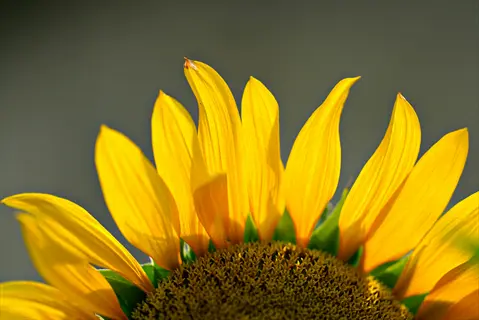
Sunflower
- Flavor Profile: Mild nutty taste with slight bitterness; young buds have artichoke-like flavor when cooked
- Appearance: Large yellow petals surrounding brown seed centers; tall stalks with coarse hairy leaves
- Culinary Uses: Steam unopened buds like artichokes; petals garnish salads; seeds roasted for snacks
- Growing Tips: Plant in full sun after frost; needs support against wind; space 2-3 feet (60-90 cm) apart
- Harvest & Storage: Harvest unopened buds; use petals same day; refrigerate in damp towels
- Nutritional Fact: High in vitamin E and selenium; seeds provide healthy fats and protein

Pansy
- Flavor Profile: Mild lettuce-like taste with subtle sweetness; tender texture ideal for fresh applications
- Appearance: Flat-faced flowers with overlapping petals in multicolored patterns; often with dark centers
- Culinary Uses: Decorate cakes and desserts; float in drinks; add to spring salads for color
- Growing Tips: Cool-season annual; plant in early spring or fall; prefers rich soil and partial shade
- Harvest & Storage: Pick fully open flowers; refrigerate between damp paper towels for 3-5 days
- Nutritional Fact: Contains antioxidants like quercetin; provides modest amounts of vitamins A and C

Arugula Flowers
- Flavor Profile: Peppery bite similar to arugula leaves but more intense; sharp mustard-like zing
- Appearance: Small white four-petaled flowers on slender stems; appear when plant bolts in heat
- Culinary Uses: Sprinkle over pizzas and pastas; garnish grain bowls; mix into potato salads
- Growing Tips: Plant in cool weather; tolerates light frost; succession plant every 2 weeks for continuous harvest
- Harvest & Storage: Collect when fully open; use immediately for best flavor and texture
- Nutritional Fact: Rich in glucosinolates, compounds with potential cancer-fighting properties

Dianthus
- Flavor Profile: Sweet clove-like spice with floral notes; petals have slightly crunchy texture
- Appearance: Fringed petals in pink, red, or white; compact plants with grass-like blue-green foliage
- Culinary Uses: Garnish fruit desserts; float in punches; candy for cake decorations and confections
- Growing Tips: Prefers full sun and alkaline soil; deadhead regularly to encourage continuous blooming
- Harvest & Storage: Pick in morning; store in refrigerator up to one week in sealed containers
- Nutritional Fact: Contains eugenol, an essential oil with antiseptic and analgesic properties
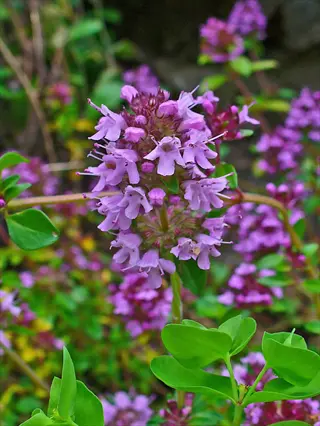
Thyme
- Flavor Profile: Milder than thyme leaves; herbal with subtle floral notes and earthy undertones
- Appearance: Tiny pale purple or white flowers on low-growing woody stems with small aromatic leaves
- Culinary Uses: Garnish roasted vegetables and meats; flavor oils and vinegars; add to bread doughs
- Growing Tips: Drought-tolerant perennial; plant in full sun with excellent drainage; prune after flowering
- Harvest & Storage: Clip flowering stems; dry upside down in bundles; store in airtight containers
- Nutritional Fact: Contains thymol and carvacrol, antimicrobial compounds that support immune function

Chamomile
- Flavor Profile: Sweet apple-like taste with honey notes; gentle floral aroma perfect for infusions
- Appearance: Small daisy-like flowers with white petals and yellow centers; feathery green foliage
- Culinary Uses: Brew relaxing teas; flavor ice creams; add to baked goods and fruit compotes
- Growing Tips: Easy annual; plant in full sun; tolerates poor soil; blooms in 6-8 weeks from seed
- Harvest & Storage: Pick flower heads when petals flatten backward; dry on screens in dark place
- Nutritional Fact: Contains apigenin, a flavonoid with calming effects that promotes better sleep
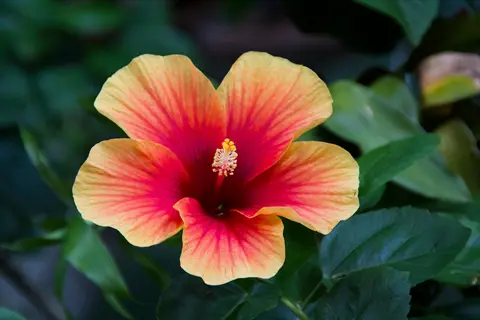
Hibiscus
- Flavor Profile: Tart cranberry-like tang with floral notes; deep red color infuses liquids beautifully
- Appearance: Large trumpet-shaped blooms in red, pink, or yellow; tropical plants with glossy leaves
- Culinary Uses: Brew tangy teas; make jams and sauces; flavor cocktails and agua frescas
- Growing Tips: Needs full sun and warm temperatures; bring indoors in zones below 9; prune annually
- Harvest & Storage: Pick fully open flowers; dry petals completely before storing in glass jars
- Nutritional Fact: Rich in vitamin C and antioxidants; may help lower blood pressure
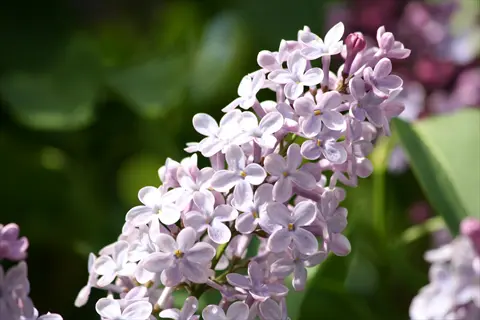
Lilac
- Flavor Profile: Perfumed floral taste with honey and citrus notes; intense aroma but delicate flavor
- Appearance: Panicles of small purple, white, or pink flowers; deciduous shrubs with heart-shaped leaves
- Culinary Uses: Infuse syrups and sugars; flavor custards and ice creams; make floral jellies
- Growing Tips: Plant in full sun; prune immediately after flowering; needs well-drained alkaline soil
- Harvest & Storage: Collect flower clusters in early morning; use same day for best flavor
- Nutritional Fact: Contains syringin, a compound with potential anti-inflammatory properties
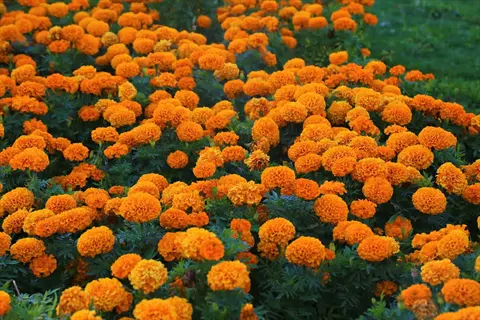
Marigold
- Flavor Profile: Citrusy tang with peppery undertones; remove bitter white base before using
- Appearance: Bright yellow or orange blooms with layered petals; compact plants with fern-like foliage
- Culinary Uses: Color rice dishes; add to soups and stews; use as saffron substitute in recipes
- Growing Tips: Easy annual; plant in full sun after frost; blooms continuously until frost
- Harvest & Storage: Pick fully open flowers; dry petals for storage; remove green parts
- Nutritional Fact: Rich in lutein and zeaxanthin, carotenoids that support eye health

Daylily
- Flavor Profile: Mild sweet taste similar to lettuce or peas; buds have asparagus-like crunch
- Appearance: Large orange, yellow, or pink trumpet-shaped flowers; grass-like foliage clumps
- Culinary Uses: Stir-fry buds with garlic; add petals to salads; stuff blossoms with fillings
- Growing Tips: Perennial in zones 3-10; divide clumps every 3-4 years; prefers full sun
- Harvest & Storage: Harvest unopened buds; use petals same day; refrigerate in damp towels
- Nutritional Fact: Contains polysaccharides and flavonoids with potential immune-boosting effects
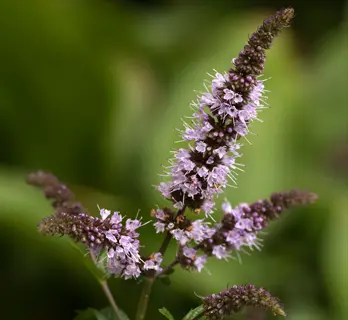
Mint
- Flavor Profile: Milder version of mint leaves; sweet with refreshing cool finish
- Appearance: Spikes of tiny purple, pink, or white flowers; square stems with serrated leaves
- Culinary Uses: Garnish desserts and drinks; infuse syrups and sauces; add to fruit salads
- Growing Tips: Plant in containers to control spreading; prefers moist soil and partial shade
- Harvest & Storage: Pick flower spikes as they open; dry for teas or freeze in oil
- Nutritional Fact: Contains menthol, which aids digestion and soothes upset stomachs
Essential Growing Guide
The key to successful gardening is soil preparation. Create a well-draining mixture by combining garden soil, compost, and sand in equal proportions. The ideal pH range for most edible flowers is between 6.0 and 7.0. Test your soil and adjust with additional lime or sulfur as necessary. This basic requirement will provide the foundation for good root development and blooming flowers.
Sunlight encourages growth. Most kinds of flowers require six hours of sun each day. Full sun lovers would include lavender and marigolds. Partial shade ones, such as violets, require only morning sun to thrive. Rotate pots to provide them with equal exposure to the sun, and use shade cloth during heat waves.
Water wisely. Apply deep watering two or three times a week to develop a deep root system. Always water before 10 AM to avoid evaporation and minimize the risk of developing fungus. Use drip irrigation instead of overhead watering. Drought-tolerant varieties, such as rosemary, will require very little moisture once established.
Adapt to your climate zone. Cool climates: 3-5 start seeds indoors before the first frost. Moderate climates 6-8 enjoy successive plantings from spring to fall. Warm climates 9-11 require afternoon shade and mulch. Humidity requires proper spacing to prevent mildew problems.
Soil Preparation
- Composition: Blend garden soil with 30% compost and 20% sand for optimal drainage
- pH Levels: Most edible flowers thrive in slightly acidic to neutral soil (6.0-7.0 pH)
- Amendments: Add lime to raise pH or sulfur to lower it based on soil test results
- Nutrient Boost: Incorporate slow-release organic fertilizer during planting
Sunlight Requirements
- Full Sun Flowers: Lavender, Marigold, and Calendula need 6+ direct sunlight hours
- Partial Shade Varieties: Violets, Mint, and Begonias thrive with morning sun only
- Seasonal Adjustment: Use shade cloth in peak summer for delicate flowers like Pansies
- Container Positioning: Rotate pots regularly for even light distribution
Watering Techniques
- Deep Watering: Soak soil thoroughly 2-3 times weekly for deep root development
- Morning Routine: Water before 10 AM to reduce evaporation and fungal risks
- Avoid Overhead Spray: Use drip irrigation to prevent petal damage and disease
- Drought-Tolerant Species: Rosemary flowers and Thyme need minimal watering
Climate Adaptation
- Cool Zones (3-5): Start seeds indoors 6-8 weeks before last frost; use cold frames
- Moderate Zones (6-8): Plant successively from early spring to late fall
- Warm Zones (9-11): Provide afternoon shade; mulch to keep roots cool
- Humidity Management: Space plants for air circulation to prevent mildew
Seasonal Care
- Spring: Apply balanced fertilizer during new growth; watch for late frosts
- Summer: Deadhead spent blooms; increase watering frequency during heat waves
- Fall: Plant cold-hardy varieties like Violas; reduce fertilization
- Winter: Protect perennials with straw mulch; move containers to sheltered areas
Pest & Disease Prevention
- Companion Planting: Grow nasturtiums near squash to repel cucumber beetles
- Organic Sprays: Use neem oil or insecticidal soap for aphid and mite control
- Preventive Measures: Remove diseased foliage immediately to stop fungal spread
- Beneficial Insects: Attract ladybugs and lacewings with yarrow and dill flowers
Culinary Mastery
Add floral notes to savory dishes. Nasturtiums can add a zesty touch of pepper to green salads and sandwiches. Squash blossoms taste best when they are stuffed with cheese and herbs, then lightly fried. Use chive blossoms on potatoes or eggs for an onion taste. Calendula petals give a gold color to soups and rice dishes.
Beautify desserts with edible flowers. Candied violets are stunning decorations for cakes. Infuse sugar with lavender for trifle-shortbread cookies. Fold rose petals into vanilla ice cream. Pansy colors fruit tarts magnificently. Borage flowers are beautifully frozen in ice cubes for summer desserts.
Prepare original drinks that have floral flavors. Hibiscus can be used to make a refreshing iced tea or agua fresca. Add dianthus to champagne to create a beautiful drink. Use mint flowers in mojitos and lemonade. Steep chamomile tea to drink before bed. Lilac syrup turns sparkling water into a refreshing spring drink.
Learn preservation methods to extend the life of your harvest. Candied delicate flower like violet with egg white and sugar. Ice borage in water or oil cubes. Infused lavender with honey for year-round use. Dried rosemary flowers for mixtures. Store nasturtiums in vinegar for quick pickles.
Savory Dishes
- Salads: Add peppery nasturtiums or chive blossoms to mixed greens with light vinaigrette
- Pasta & Grains: Stir squash blossoms into risotto or sprinkle pansies over pasta primavera
- Proteins: Top grilled fish with dill flowers; garnish roast chicken with thyme blossoms
- Vegetables: Toss roasted root vegetables with crispy fried calendula petals
Sweet Creations
- Baking: Embed candied violets in shortbread; fold rose petals into cake batter
- Desserts: Float borage flowers in lemon sorbet; infuse lavender into crème brûlée
- Confections: Crystalize pansies for cupcake decorations; make hibiscus fruit leather
- Preserves: Steep chamomile in honey; create lilac-infused jams and jellies
Beverages
- Hot Drinks: Brew bee balm or mint flowers for herbal teas; add rose petals to chai
- Cold Infusions: Steep hibiscus overnight for tangy agua fresca; freeze violets in ice cubes
- Cocktails: Garnish gin tonics with borage; float dianthus in champagne flutes
- Syrups: Simmer elderflowers with sugar for cordials; make marigold simple syrup
Garnishing Techniques
- Texture Contrast: Use crispy fried sage flowers on soups; sprinkle delicate chamomile on custards
- Color Placement: Arrange concentric circles of calendula on grain bowls; create floral mosaics
- Last-Minute Adds: Apply heat-sensitive flowers like pansies after plating hot dishes
- Edible Arrangements: Thread chive blossoms onto skewers; make floral butter pats
Preservation Methods
- Drying: Hang lavender bundles upside down; dehydrate rose petals for tea blends
- Freezing: Preserve mint flowers in olive oil cubes; store nasturtiums in vinegar
- Candying: Brush violet petals with egg white and caster sugar; air-dry for 24 hours
- Infusing: Soak chamomile in vodka for tinctures; steep hibiscus in apple cider
Harvest & Safety Protocol
Cut flowers when they are at the peak of their freshness. Gather the nasturtiums and pansies between the hours of 8 and 10 a.m., after the dew is off. Gather the heat-sensitive violets before the temperature reaches 75°. The arugula blooms should be gathered as soon as they open, as they become bitter. Marigolds should be cut at regular intervals of three or four days in order to encourage fresh growth.
Rinse flowers carefully. Rinse soft pansies in cold water. Soak strong flowers like roses in a vinegar solution for 5 minutes. Use paper towels to gently pat the flowers dry, or use a salad spinner for a more thorough drying process. Avoid using non-organic flowers due to the risk of pesticide contamination. Flowers grown in the house require a wait of 48 hours.
For best results, store correctly. Refrigerate lavender in sealed containers up to five days. Freeze borage in ice cubes for three months. Hang chamomile upside-down to dry up to two weeks. Infuse calendula in oil for six months, Mark containers with the date of harvest.
Recognize toxic lookalikes. True violets bear heart-shaped leaves, unlike scabrous-stemmed deadnettle. Chamomile has hollow centers, while poisonous feverfew is solid. Queen Anne's lace has hairy stems, poisonous hemlock purple-spotted and smooth. Daylily buds differ from toxic iris buds, growing from rhizomes.
Optimal Harvest Timing
- Morning Harvest: Pick flowers like nasturtium and pansies after dew evaporates (8-10 AM) for peak freshness
- Heat-Sensitive Varieties: Harvest delicate blooms like violets before temperatures exceed 75°F (24°C)
- Bolting Plants: Collect arugula and herb flowers immediately after blooming to prevent bitterness
- Continuous Bloomers: Regularly pick calendula and marigolds every 2-3 days to encourage new growth
Cleaning Procedures
- Gentle Rinse: Submerge fragile flowers like pansies in cold water; swish gently to remove insects
- Vinegar Solution: Soak sturdier blooms (roses, daylilies) in 1:3 vinegar-water solution for 5 minutes
- Drying Method: Pat dry with paper towels or use salad spinner on low speed to prevent bruising
- Pesticide Removal: Discard commercially grown non-organic flowers; homegrown requires 48-hour withholding period
Storage Methods
- Refrigeration: Keep in airtight containers lined with damp paper towels (lavender: 5 days; squash blossoms: 1 day)
- Freezing: Preserve in ice cubes or vacuum-sealed bags (borage: 3 months; rose petals: 6 months)
- Drying: Hang bundles upside-down in dark, ventilated areas (chamomile: 2 weeks; thyme flowers: 10 days)
- Infused Oils: Store in dark glass bottles (calendula oil: 6 months refrigerated)
Toxic Lookalike Identification
- Violets vs. Deadnettle: True violets have heart-shaped leaves; deadnettle stems are square and toxic
- Chamomile vs. Feverfew: Chamomile has hollow yellow centers; feverfew has solid centers and bitter taste
- Wild Carrot vs. Hemlock: Edible Queen Anne's lace has hairy stems; poisonous hemlock has purple-spotted smooth stems
- Daylily vs. Iris: Daylilies have edible buds; iris buds are toxic and grow from rhizomes
Allergen Precautions
- Pollen Sensitivity: Remove stamens/pistils from lilies and hibiscus before consumption
- Ragweed Allergy Warning: Avoid chamomile if allergic to ragweed (cross-reactivity risk)
- Skin Test: Rub petal on inner wrist; wait 2 hours for reactions before ingesting new varieties
- Dosage Limits: Limit consumption to 1-2 tablespoons daily; overconsumption may cause digestive upset
Pollinator & Garden Synergy
Plant borage and lavender to lure bees with a constant source of nectar. Sunflowers promote very active bumblebee populations. Rosemary offers food supplies early in the spring. For butterflies, use zinnias for landing pads and milkweed as a host plant for monarch caterpillars. Bee balm attracts the popular butterfly, the swallowtail, supplying bees with sugar-rich nectar.
Introduce companion planting practices. Plant nasturtiums in proximity to vegetables to absorb the aphids. Utilize marigolds as a deterrent to the nematodes around the tomatoes. MM Plant chamomile near other herbs to increase essential oil yields. Create lavender hedges that repel deer and attract pollinators for fruit trees.
Plan flowering times for continuous nectar availability. Start with the crocus and rosemary in early spring. Use echinacea during the hot summer months. Extend into the fall months with aster and goldenrod . Let evergreen herbs take place of flowers during the winter months for a source of shelter and continuous supplies.
Improve habitats outside of just planting. Provide shallow water bowls with stones for drinking. Leave some bare ground for nesting sites for ground-nesting bees. Stay completely away from pesticides. Provide bee hotels for solitary species. Rotate plantings to maintain healthy soils and discourage pest build-up.
Bee-Attracting Flowers
- Borage: Star-shaped blue blooms produce nectar continuously through daylight hours
- Lavender: Dense purple spikes offer high nectar concentration favored by honeybees
- Sunflower: Large pollen-rich centers support bumblebee colonies in late summer
- Rosemary: Early spring blooms provide critical food when other sources are scarce
Butterfly Magnets
- Zinnia: Flat landing pads in bright colors allow easy nectar access for monarchs
- Bee Balm: Tubular red flowers attract swallowtails with their high-sugar nectar
- Milkweed: Essential host plant for monarch caterpillar development stages
- Phlox: Clustered blooms offer feeding stations for painted lady butterflies
Hummingbird Favorites
- Cardinal Flower: Bright red tubular blooms perfectly shaped for long beaks
- Columbine: Nodding flowers with deep nectar reservoirs accessible to hovering birds
- Salvia: Continuous blooming from spring to fall provides reliable food source
- Trumpet Vine: Large orange flowers support high-energy needs during migration
Companion Planting Benefits
- Nasturtium Trap Crop: Plant near brassicas to lure aphids away from vegetables
- Marigold Guardians: Root secretions deter nematodes around tomato plants
- Chamomile Boost: Increases essential oil production in nearby basil and mint
- Lavender Hedge: Repels deer and rabbits while attracting pollinators to fruit trees
Seasonal Bloom Sequencing
- Early Spring: Crocus and rosemary provide first nectar after winter dormancy
- Mid-Summer: Echinacea and lavender peak during highest pollinator activity
- Late Fall: Asters and goldenrod sustain migrating monarchs and bees
- Year-Round: Evergreen herbs like rosemary offer winter shelter for beneficial insects
5 Common Myths
Brightly colored flowers are safe because bright colors mean nature has made them edible.
Color is not a good safety indicator. Many toxic plants such as foxglove and oleander have bright colors. Eat only those varieties that have been shown to be edible either in good foraging guides or something grown. Always check in with plant-identification apps before eating.
Thoroughly washing flowers removes all pesticide residues so that supermarket flowers are safe for human consumption.
Although pesticides enter into the cells of petals, they cannot be completely removed by washing. Commercial flowers often have systemic poisons introduced into the plant through the roots. Use flowers only that are organically grown, and that are labelled for culinary use. Flowers of your own growing are safe if they have not been sprayed with poisons for at least six weeks before harvesting.
The taste of edible flowers is typically one of sweetness or flower. They lack the complex flavors found in herbs or vegetables.
The divergence in flavor is very marked in the different species. The nasturtium gives a hotness similar to that of radishes; the borage a freshness akin to cucumbers. The chrysanthemum gives a slight bitterness which combines well with rich dishes. Taste in little quantities until the savory, the pungent and herbal flavor is detected.
Wildflowers are safer than cultivated flowers because they grow in nature, where they are not dependent on chemical supervision.
Wild flowers are endangered because they may be contaminated by street poisons, animal manures or mistaken identity. There are many toxic-look-alikes, such as poison hemlock, which is like a safe species. Wild food fanciers should only try wild numbers under expert directions and avoid localities adjoining roads or factories. Cultivated flowers can be counted on for safeness, under control.
You can safely use unlimited amounts of edible flowers in recipes because they are all natural and non-toxic.
Over-eating, however, may cause intestinal disturbance because of the amount of concentrated ingredients present. It is advisable to limit the use of these flowers to about one or two tablespoons in one serving, particularly in such potent varieties as lavender. They should be introduced, however, slowly and cautiously, so that reactions, if any, may be watched for. Children and patients who are pregnant should consult their physician before using such flowers in food.
Conclusion
Experience the journey from garden to gourmet plate in a single growing season. Edible flowers will turn tasks into gourmet masterpieces. Their colors and tastes will add beauty to mundane dishes. This change comes about rapidly and with great ease. Your gourmet garden becomes an extension of the kitchen.
Experience amazing versatility with twenty varieties for sweet, savory, and beverage applications. Use pansies for dessert color or borage for refreshing drinks, stuff squash blossoms for appetizers. Use lavender to flavor baked goods. Each flower has several culinary uses waiting to be explored through experimentation.
Find the most satisfying balance of beauty and food. Properly harvested flowers are visually attractive and nutritious. Recognize the safe plants, such as nasturtiums. Harvest flowers in the morning. Please don't confuse them with poisonous lookalikes. This is why every blossom adds pleasure and food value.
Start your adventure with edible flowers this week by growing easy nasturtiums, which require minimal care and space. Plant them in containers or at the edges of your garden. In no time, you will be able to harvest a handful of blossoms here and there, adding the peppery blossoms to your salads for a different flavor. Starting small can lead to great gourmet opportunities!
External Sources
Frequently Asked Questions
What are the most common edible flower varieties?
Popular edible varieties include nasturtiums, pansies, lavender, roses, borage, calendula, violets, and squash blossoms. Each offers unique flavors from peppery to sweet, with culinary uses ranging from salads to desserts. Beginners should start with mild varieties like pansies or nasturtiums.
Are there flowers that are dangerous to eat?
Yes, many toxic flowers resemble edible ones. Critical avoidances include:
- Foxglove (digitalis toxins affect heart rhythm)
- Oleander (causes severe digestive and cardiac issues)
- Hemlock (resembles wild carrots but paralyzes nervous system)
- Lily-of-the-valley (contains convallatoxin)
- Hydrangeas (cyanogenic glycosides cause cyanide poisoning)
What flowers do professional chefs use most?
Chefs favor versatile flowers for visual appeal and flavor:
- Nasturtiums: Peppery kick in salads
- Borage: Cucumber notes in cocktails
- Calendula: Saffron substitute for coloring rice
- Squash blossoms: Stuffed/fried in savory dishes
- Candied violets: Elegant dessert decorations
Can beginners easily grow edible flowers?
Yes, starter-friendly varieties like nasturtiums, calendula, and pansies thrive with minimal care. They need well-draining soil, regular sunlight, and occasional watering. These resilient plants yield blooms in 6-8 weeks with no advanced gardening skills required.
How do I safely prepare edible flowers?
Essential safety steps include:
- Verify species identity using botanical guides
- Wash gently in vinegar solution to remove contaminants
- Remove pistils/stamens from lilies/hibiscus
- Test for allergies with skin contact first
- Source organic or homegrown (avoid commercial non-food blooms)
What are health benefits of edible flowers?
Many varieties offer nutritional advantages:
- Nasturtiums: Rich in vitamin C and antibacterial compounds
- Borage: Gamma-linolenic acid for skin health
- Calendula: Anti-inflammatory flavonoids
- Roses: Collagen-boosting vitamin C
- Lavender: Stress-reducing linalool
Can I use flowers from my garden for cooking?
Yes, if grown without pesticides and correctly identified. Safe homegrown options include chive blossoms, thyme flowers, and marigolds. Always harvest in morning after dew dries, and avoid roadside or polluted areas. Never use chemically treated blooms.
Which flowers work best for candying?
Ideal candidates hold shape and have sturdy petals:
- Violets: Sweet wintergreen flavor
- Pansies: Colorful and crisp texture
- Rose petals: Fragrant and visually striking
- Lilacs: Delicate honey-citrus notes
- Borage: Holds well in syrup baths
How do edible flowers enhance garden ecosystems?
They attract pollinators like bees and butterflies while repelling pests. For example, marigolds deter nematodes, while lavender wards off deer. This natural synergy reduces pesticide needs and boosts vegetable yields through companion planting benefits.
What preservation methods work for edible flowers?
Effective techniques include:
- Freezing in ice cubes or oil (preserves borage/mint)
- Drying upside-down in dark spaces (lavender/chamomile)
- Infusing in vinegars or oils (calendula/rose)
- Candying with egg white and sugar (violets/pansies)
- Refrigerating in damp towels (short-term for squash blossoms)
